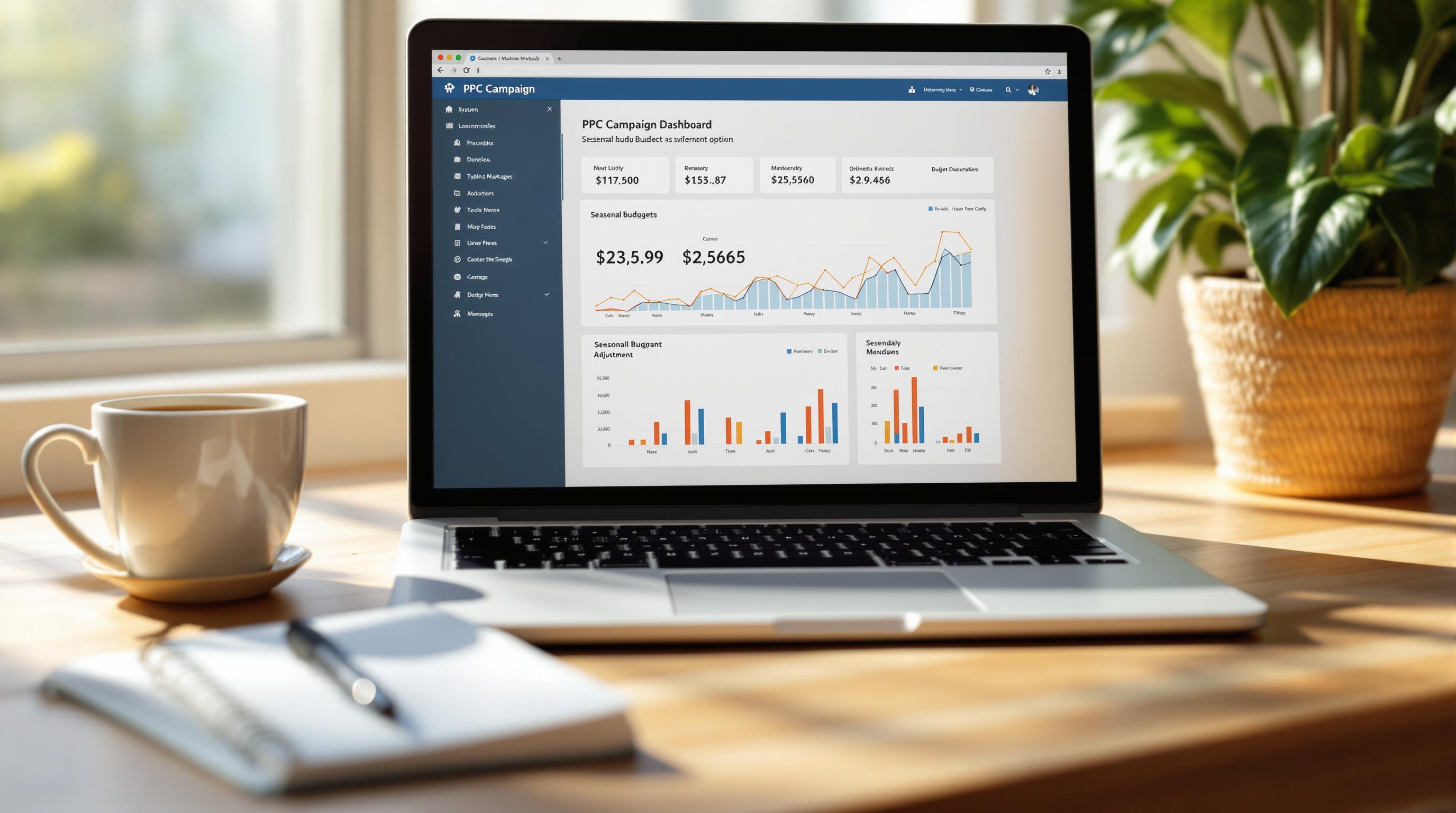Emotional triggers in PPC ads can significantly improve engagement and conversions by tapping into human psychology. Here's why they work:
- Build Instant Connections: Emotions resonate more deeply than logic.
- Encourage Quick Decisions: Emotional appeals bypass lengthy decision-making.
- Boost Conversion Rates: Ads that evoke emotions often outperform others.
Key Emotional Triggers to Use:
- Fear of Missing Out (FOMO): "Only 3 spots left – Book now!"
- Trust: "Trusted by thousands of satisfied customers."
- Urgency: "Flash sale ends in 24 hours."
- Belonging: "Join a community of smart shoppers."
- Achievement: "Transform your career with our tools."
Quick Tips for Success:
- Highlight Pain Points: Address customer frustrations directly.
- Use Emotion-Driven Words: Words like "now", "guaranteed", and "success" drive action.
- Test and Optimize: A/B test emotional messages to find what works best.
- Tailor by Platform: Adjust emotional triggers for Google Ads, Facebook, or LinkedIn.
Emotional triggers are a powerful way to make your PPC ads stand out and connect with your audience. Focus on genuine emotions, pair them with clear benefits, and continuously test for better results.
What Makes Emotional Triggers Work in Ads
What Are Emotional Triggers?
Emotional triggers are psychological cues designed to spark quick, automatic reactions from consumers. In PPC advertising, they tap into core human emotions - like fear, desire, trust, or urgency - to influence decisions like clicking on an ad or completing a purchase. By appealing directly to emotions, these triggers bypass lengthy decision-making processes and encourage immediate action.
How Emotions Influence PPC Results
Using emotional triggers in PPC campaigns can significantly boost performance. By forging a quick connection with viewers, emotional elements can make your brand more memorable, speed up decision-making, and build stronger customer relationships. Ads that incorporate emotional triggers often see better engagement rates and more efficient results.
Common Emotional Triggers in Ads
Here are some of the most frequently used emotional triggers in PPC advertising:
| Emotional Trigger | How It’s Used | Sample Ad Copy |
|---|---|---|
| Fear of Missing Out (FOMO) | Highlighting scarcity or exclusivity | "Only 3 spots left – Book now!" |
| Trust and Security | Emphasizing reliability or social proof | "Trusted by thousands of satisfied customers" |
| Achievement | Focusing on personal success or growth | "Join thousands of professionals who advanced their careers" |
| Belonging | Creating a sense of community or shared values | "Join a community of smart shoppers" |
| Urgency | Stressing time-sensitive opportunities | "Flash sale ends in 24 hours" |
To make these triggers effective, ensure they align with the genuine needs and desires of your audience. Since different groups may respond to triggers differently, testing and refining your approach is essential for success.
Next, we’ll dive into how to create emotion-driven PPC ads that resonate with your audience.
Top Emotional Triggers for PPC Ads
Using Fear and Time Pressure
Urgency can be a powerful motivator when done right. Focus on real scarcity and deadlines that highlight actual value. Here are some effective examples:
- Limited-time offers: "48-hour flash sale ends March 14"
- Inventory alerts: "Only 5 units remain at this price"
- Seasonal deadlines: "Last chance for guaranteed delivery before Easter"
The key is to create urgency while staying genuine. Pair these time-sensitive messages with clear benefits to encourage action without coming across as manipulative.
Building Trust and Safety
Reassuring potential customers is crucial. Use specific elements to show reliability and reduce hesitation:
| Trust Element | Example Implementation |
|---|---|
| Money-back guarantee | "60-day satisfaction guarantee - reduces purchase risk" |
| Security badges | "Norton Secured, SSL certificates - increases checkout confidence" |
| Industry certifications | "BBB accreditation, professional licenses - builds credibility" |
| Performance metrics | "99.9% uptime guaranteed - demonstrates reliability" |
These trust signals help establish confidence and make it easier for customers to commit.
Creating Interest and Wonder
Grab attention by sparking curiosity and focusing on improvement. Here’s how:
- Problem-solution format: Tackle specific challenges with clear solutions.
- Benefit-driven headlines: Highlight how your product or service creates positive change.
- Question-based copy: Engage readers with thought-provoking questions.
For instance, instead of saying, "Buy our software", try, "What if your team could save 5 hours every week?" This approach invites readers to imagine the benefits.
Social Proof and Community
People trust what others trust. Use social proof to show your product or service is a popular and reliable choice:
- Specific numbers: "Join 50,000+ satisfied customers"
- Expert endorsements: Recommendations from industry leaders
- Achievement markers: "Rated #1 by [Industry Publication]"
- User testimonials: Short, results-focused quotes from real users
These strategies make your offering feel credible and widely accepted, encouraging more people to take action.
Writing Emotion-Based PPC Ads
Finding Customer Pain Points
To connect with your audience, start by identifying their emotional triggers. Here's how you can dig into their frustrations:
- Customer reviews: Look for recurring complaints or desires.
- Support tickets: Spot patterns in the issues customers frequently report.
- Social media: Pay attention to challenges they share online.
- Sales calls: Gather insights directly from conversations.
Use this data to build customer personas and link emotional triggers to specific audience groups.
Emotion-Driven Words and Phrases
The language you use in ads can make or break their performance. Here’s how specific emotions and words can shape your messaging:
| Emotion | Power Words | Usage Example |
|---|---|---|
| Urgency | Now, Today, Limited | "Start saving now – offer ends soon." |
| Trust | Guaranteed, Proven | "Guaranteed results for satisfied customers." |
| Achievement | Success, Transform | "Transform your digital marketing strategies." |
| Relief | Solution, Fix, Resolve | "Finally resolve your tracking issues." |
Choose words that resonate with your audience's feelings and align with their needs.
Mixing Emotions with Benefits
Pair emotional appeals with clear benefits to create compelling ads. Use this simple structure:
- Start with emotion: Acknowledge the pain point.
- Introduce the solution: Explain how your product or service helps.
- Show the benefits: Highlight what they’ll gain.
- Add urgency: Encourage immediate action.
For example: "Struggling with low conversion rates? Our AI-powered tool boosts your click performance. Start your free trial today!"
Fine-tune this approach by experimenting with different emotional angles.
A/B Testing Emotional Messages
Testing is key to finding what works best. Follow these steps to evaluate and optimize your emotional messaging:
- Create multiple ad variations, each focusing on a specific emotional trigger.
- Adjust elements like headlines, descriptions, and calls-to-action.
- Track performance metrics such as click-through rate (CTR), conversion rate, and cost per conversion.
- Scale the winning emotional triggers across your campaigns.
This method ensures your ads resonate with your audience while driving measurable results.
Platform-Specific Emotional Triggers
Google Ads Implementation Guide
Creating effective Google Ads requires a thoughtful approach to emotional triggers, especially since the format is heavily text-based. Here’s how to make your ads resonate:
- Headline: Include powerful, emotion-driven words that grab attention.
- Description Lines: Focus on emotional benefits while keeping your message straightforward.
- Ad Extensions: Use sitelinks and callouts to amplify emotional appeal.
To match your ad copy with the audience’s search intent, consider these examples:
| Search Intent | Emotional Trigger | Example Copy |
|---|---|---|
| Problem-aware | Frustration/Hope | "Low ROI? Boost your PPC results now" |
| Solution-aware | Trust/Security | "Discover data-driven PPC solutions that deliver results" |
| Product-aware | Achievement/Success | "Join many marketers experiencing enhanced returns" |
Once you’ve nailed down your Google Ads, it’s time to tailor your approach for social media platforms.
Social Media Ad Strategies
Different social platforms call for different emotional tactics. Here’s how to adapt:
-
Facebook and Instagram:
- Focus on lifestyle and aspirational themes.
- Use carousel ads and storytelling to draw viewers in.
- Highlight real experiences with user-generated content.
- Leverage video content to create emotional connections.
-
LinkedIn:
- Emphasize professional growth and achievement.
- Showcase authority and expertise in your industry.
- Use data-backed emotional appeals.
- Highlight opportunities for career advancement.
Now, let’s explore how design can visually enhance these emotional triggers.
Display Ad Design Tips
The right design can amplify emotional triggers. Here’s how to make your display ads stand out:
-
Color Psychology:
- Blue: Evokes trust and security.
- Red: Creates a sense of urgency.
- Yellow: Conveys optimism and energy.
- Green: Suggests growth and success.
-
Visual Hierarchy:
- Place key emotional elements prominently.
- Use contrasting colors and clear spacing for emphasis.
- Include human faces to foster connection.
-
Design Elements:
- Use visuals that reflect the emotions you want to evoke.
- Add motion sparingly to maintain focus.
- Keep text concise but impactful.
- Maintain a consistent style that aligns with your brand identity.
sbb-itb-89b8f36
Tracking Emotional Ad Performance
Key Performance Metrics
To measure how well emotional appeals work in your PPC campaigns, focus on these metrics:
| Metric | What It Measures | Why It Matters |
|---|---|---|
| Click-Through Rate (CTR) | The percentage of users who click on your ad after seeing it | Indicates how effectively your ad grabs attention |
| Conversion Rate | The percentage of clicks that lead to desired actions (like purchases or sign-ups) | Shows whether emotional appeals are driving meaningful results |
| Cost Per Acquisition (CPA) | The cost of acquiring each customer | Helps assess the financial efficiency of your emotional messaging |
Performance Data Analysis
Leverage analytics tools to dive deeper into audience engagement:
-
Real-Time Monitoring
Use PPC tools like Adzooma or WordStream to track how your emotional ads are performing. Segment your data by demographics and user behavior to uncover trends. Look for patterns across different emotional appeals and platforms. -
Cross-Channel Analysis
Compare how emotional ads perform across platforms. Pay attention to seasonal or time-based variations to spot trends. Identify which emotional triggers work best on each channel.
These insights can help you fine-tune your emotional messaging for better results.
Improving Emotional Ad Results
Refine your emotional ad strategy using performance data:
- Testing Framework
Optimize emotional triggers through data-driven testing. Change one variable at a time to isolate its impact. Make decisions based on statistically significant results to ensure accuracy.
The Psychology Of Great PPC Ad Copywriting
PPC Ad Tools and Resources
Boost the emotional appeal of your PPC ads with tools designed to refine copy, test strategies, and track results. These resources build on the concept of emotion-driven copywriting and performance tracking, ensuring your campaigns make the most of every emotional trigger.
| Tool Category | Key Features | How It Helps with Emotional Triggers |
|---|---|---|
| Ad Copy Optimization | Improves emotional messaging | Enhances the impact of your ad content |
| A/B Testing | Split testing capabilities | Pinpoints the most effective emotional angles |
| Performance Tracking | Analytics and reporting | Evaluates how well emotional triggers work |
| Competitive Analysis | Market benchmarking | Highlights successful emotional strategies in your niche |
Recommended Platforms for Emotion-Based PPC Management
- Adzooma: Offers precise A/B testing tools, perfect for experimenting with emotional appeals.
- WordStream: Provides ad copy evaluation features to gauge the impact of emotional messaging.
- Optmyzr: Automates the optimization process, making it easier to incorporate emotional triggers effectively.
For more specialized tools and services, check out the Top PPC Marketing Directory below.
Top PPC Marketing Directory
The Top PPC Marketing Directory is your go-to resource for finding tools and agencies that excel in emotional trigger optimization. Here's what it offers:
- Campaign Management Tools: Simplify the use of emotional triggers across campaigns.
- Ad Copy Optimization Services: Focused on testing and refining emotional messaging.
- Performance Tracking Solutions: Tools to measure the impact of emotional strategies.
- Expert Agencies: Specialists in crafting emotion-driven PPC strategies.
When exploring directory options, look for solutions that provide real-time monitoring, cross-channel optimization, automated testing, integration with major platforms, and detailed emotional impact analytics. These features help you efficiently manage and fine-tune emotional triggers while delivering actionable insights.
Conclusion
Using emotional triggers can significantly improve the effectiveness of your PPC campaigns. By applying the strategies outlined earlier, you can create ads that resonate deeply with your audience and drive results.
Here’s why emotional triggers work so well in PPC campaigns:
- Targeted Messaging: Align emotional triggers in your ad copy with specific customer pain points.
- Platform-Specific Tactics: Tailor emotional approaches to fit the unique dynamics of each advertising platform.
- Continuous Improvement: Use A/B testing to monitor performance and refine your approach based on key metrics.
Next steps to consider:
- Experiment with new emotional triggers on a smaller scale.
- Monitor performance metrics like click-through rates and conversions.
- Expand the use of triggers that show strong results.
- Use PPC tools to streamline testing and implementation.
Emotional triggers help build stronger connections with your audience, leading to more effective campaigns. By combining thoughtful emotional messaging with consistent testing, you can create ads that not only engage but also convert.
To keep improving, explore specialized PPC tools and resources. These can help you fine-tune your emotional trigger strategies and maximize campaign performance across platforms. For additional support, check out resources like the Top PPC Marketing Directory, which offers solutions for implementing emotion-based ad strategies effectively.
Apply these insights to elevate your PPC campaigns at every stage.


